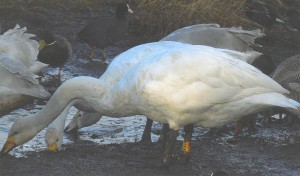Sigrunn the Swan Scientist
 Like many of our named whooper swans, Sigrunn has been a regular visitor to Martin Mere over the years. He was first caught in December 2002, as an adult, and was given a plastic darvic ring on his right leg with the number LP7, to enable him to be spotted from a distance. He spent the winter in the area, and was seen in mid-March the next year, before returning to Iceland for the summer. For the next 5 years, life continued in the same pattern. Sigrunn was spotted with an unringed mate and 2 cygnets in October 2007.
Like many of our named whooper swans, Sigrunn has been a regular visitor to Martin Mere over the years. He was first caught in December 2002, as an adult, and was given a plastic darvic ring on his right leg with the number LP7, to enable him to be spotted from a distance. He spent the winter in the area, and was seen in mid-March the next year, before returning to Iceland for the summer. For the next 5 years, life continued in the same pattern. Sigrunn was spotted with an unringed mate and 2 cygnets in October 2007.
In the winter of 2008, however, change was on its way for Sigrunn. With an increasing need for sustainable energy sources, a number of wind farms were being planned around the coast of the UK. WWT and other groups were naturally concerned about the effect new wind farms would have on our migratory birds, in particular the larger Whooper swans. Weighing in at 10-12kg, whooper swans are less able to manoeuvre around obstacles in the air than smaller birds, and flying accidents are a major cause of death in this species. A plan was developed to fit 60 whooper swans across 3 WWT sites with GPS transmitters with the aim of mapping their migratory routes. Sigrunn, being one of the larger males at Martin Mere, was a prime candidate.
Until this point, Sigrunn had only been known by his ring designation, LP7, but when caught on 28th January 2009 and fitted with transmitter number 63, it was decided he needed a name, and so LP7 became Sigrunn. The 70g white transmitters gave the 20 swans sporting them at Martin Mere the appearance of wearing a sort of swan backpack. The straps used were made from knicker elastic - strong enough to hold them in place, but designed to snap if they became caught. The swans wearing transmitters continued to go about their daily routines, none the worse for wear despite their unusual fashion accessory.
Sigrunn left for Iceland on 4th March 2009, and researchers waited for the first transmission. The next morning at 10am, a transmission was received that placed Sigrunn at Loch Connell, near Stranraer, Dumfries and Galloway. The transmission received at 10am the next day (6th March), placed him around Coll in the Inner Hebrides. He spent the rest of the day on the move, and after a brief pitstop on Loch Bi, South Uist, he headed out to sea on the evening of 7th March. He was definitely on his way home!
Unfortunately, the weather closed in, and Sigrunn was forced to make an emergency landing on the sea and wait it out. The weather didn’t improve, however, so after a few hours out on open water he returned to South Uist in the early hours of 8th March. By 9am on 10th March, the weather had improved, and Sigrunn resumed his journey. Reaching speeds of over 60mph, and flying up to 58m above sea level, he reached the south coast of Iceland by 10pm the same day. He was back at his nesting site at Rangarbakki in southern Iceland by 13th March.
Sigrunn arrived back at Martin mere the next winter, with his mate and 2 new cygnets. He ditched his transmitter somewhere on the reserve before he could be caught again on 10th February 2010. After a thorough health check, it was clear that Sigrunn had no ill effects either from carrying the transmitter or from his protracted journey back to Iceland. He was given a replacement darvic leg ring with the number X4H, as his old ring had become cracked. His transmitter was not recovered until April 2013 – it was identified as Sigrunn’s transmitter by a label on side which was fortunately still legible after more than 3 years exposed to the elements. Though he had managed to hide it rather well, Sigrunn didn’t manage to completely destroy all the evidence of his time as a swan scientist.
In addition to helping us to map the migratory routes and prevent unnecessary bird deaths by influencing the location of wind farms, swans like Sigrunn also provided extremely useful insights into swan behaviour during migration, something that is difficult to observe on the ground. So, though he may not know it, Sigrunn made a vital contribution to the fields of wildlife conservation and ornithology. Sigrunn and his mate continue to return to Martin Mere each year with their cygnets. If you’re visiting Martin mere this winter, why not see if you can spot him on the mere?
